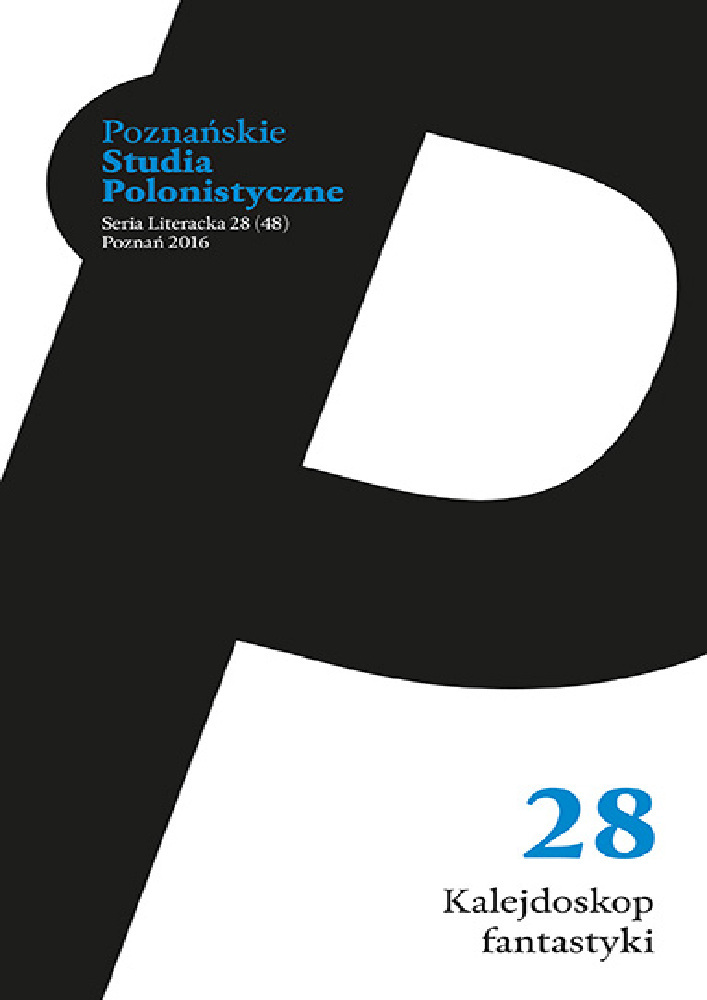Abstract
From the 18th century on Arabian Nights has been influencing European imaginary, especially culture and literature. It created European vision of the Orient as well. In the 20th century popular culture gave high recognisability to many elements of Arabian Nights (such as characters: Sindbad, Aladdin or magical artefacts: a flying carpet, magic lamp). Scheherazade as an allegory for narrative art became the most important figure for scholars studying the book. The paper shows how two contemporary book cycles make intertextual links to Arabian Nights . Orphan’s Tale by Catherynne M. Valente, Harun and the Sea of stories and Luka and the fire of Life by Salman Rushdie rewrite the elements of Arabian Nights , such as characters, artefacts and linguistic allusion to the Orient. However, the narration in the works by both writers is completely different: Valente recreated a sophisticated device of narration known from the book, whereas Rushdie gave his novels a simple, linear composition. Scheherazade’s gift to spin story out of a life is needed for different aims. For Rushdie telling fairy tales is useful in writing about life of literature itself, for Valente it is important for creating an alternative to the patriarchal vision of the world.References
Barth John (1983), Literatura wyczerpania, przeł. Jacek Wiśniewski, w: Nowa proza amerykańska. Szkice krytyczne, wybór i wstęp Zbigniew Lewicki, Czytelnik, Warszawa, 38-55.
Beaumont David (2007), Literary Style and Narrative Technique in the „Arabian Nights”, w: Marzolph Ulrich, van Leeuwen Richard, Wassouf Hassan, The Arabian Nights. Encyclopedia, ABC-CLIO, Santa Barbara, s. 1-5.
Beckett Sandra L. (2009), Crossover Fiction. Global and Historical Perspectives, Routledge, New York–London.
Bettelheim Bruno (1985), Cudowne i pożyteczne. O znaczeniach i wartościach baśni, t. 1, przełożyła i przedmową opatrzyła Danuta Danek, PIW, Warszawa.
Brzóstowicz-Klajn Monika (2012), Tomasz Morus w mundurku pioniera, czyli utopia i utopijność w polskim socrealizmie, Wydawnictwo Naukowe UAM, Poznań.
Chrobak Małgorzata (2010), Realizm magiczny w polskiej literaturze dla dzieci i młodzieży, Wydawnictwo Naukowe Uniwersytetu Pedagogicznego, Kraków.
Deszcz Justyna (2001), Frank Baum’s „The Wonderful Wizard of Oz” and Salman Rushdie’s „Haroun and the Sea of Stories”: Oz as One of Rushdie’s Literary Passports from the Book to the World, „Acta Universitatis Wratislaviensis. Anglica Wratislaviensia”, nr 37, s. 17-33.
Deszcz-Tryhubczak Justyna (2005), Harun i morze opowieści: baśń dla dzieci od lat siedmiu do siedemdziesięciu, w: Baśnie nasze współczesne, red. Jolanta Ługowska, Polskie Towarzystwo Ludoznawcze, Wrocław, s. 151-169.
Głowiński Michał (2000), O stylizacji, w: tegoż, Prace wybrane, t. 5: Intertekstualność, groteska, parabola. Szkice ogólne i interpretacje, Universitas, Kraków, s. 53-72.
Kabbani Rana (2007), The Arabian Nights as an Orientalist Text, w: Marzolph Ulrich, van Leeuwen Richard, Wassouf Hassan, The Arabian Nights. Encyclopedia, ABC-CLIO, Santa Barbara, s. 25-29.
Kubale Anna (1984), Dziecko romantyczne. Szkice o literaturze, Ossolineum, Wrocław.
Lasoń-Kochańska Grażyna (2008), Kobiety opowiadają świat. Szkice o fantastyce, Wydawnictwo Naukowe Akademii Pomorskiej w Słupsku, Słupsk.
Lewicki Tadeusz (1974), Wstęp, w: Księga tysiąca i jednej nocy, t. 1, przeł. Andrzej Czapkiewicz i in., PIW, Warszawa, s. 5-46.
Little Douglas (2008), American Orientalism. The United States and Middle East since 1945, The University of North Carolina Press, Chapel Hill.
Marzolph Ulrich, van Leeuwen Richard, Wassouf Hassan (2007), The Arabian Nights. Encyclopedia, ABC-CLIO, Santa Barbara.
Miller Nancy K. (2007), Arachnologie: kobieta, tekst i krytyka, przeł. Anna Burzyńska, w: Teorie literatury XX wieku. Antologia, red. Anna Burzyńska, Michał Paweł Markowski, Universitas, Kraków, s. 487-513.
Propp Vladimir (2003), Historyczne korzenie bajki magicznej, przeł. Jacek Chmielewski, KR, Warszawa.
Rollason Christopher (2012), An Unsurprising World of Magic? „Journal of the Odisha Association for English Studies”, t. 12, nr 1, s. 210-214, [dostęp: 25 stycznia 2016], https://rollason.wordpress.com/2011/02/22/an-unsurprising-world-of-magic-%E2%80%93-review-of-salman-rushdie-luka-and-the-fire-of-life.
Rushdie Salman (2010a), Harun i morze opowieści, przeł. Michał Kłobukowski, Rebis, Poznań.
Rushdie Salman (2010b), Luka i ogień życia, przeł. Michał Kłobukowski, Rebis, Poznań.
Rosner Katarzyna (2006), Narracja, tożsamość i czas, Universitas, Kraków.
Said Edward (2005), Orientalizm, przeł. Monika Wyrwas-Wiśniewska, Zysk i S-ka, Poznań.
Seifert Lewis C. (2006), Fairy Tales, Sexuality and Gender in France 1690-1715. Nostalgic Utopias, Cambridge University Press, Cambridge.
Showalter Elaine (1993), Krytyka feministyczna na bezdrożach, przeł. Izabela Kalinowska-Blackwood, „Teksty Drugie”, nr 4/5/6, s. 115-146.
Świerkosz Monika (2014), W przestrzeniach tradycji. Proza Izabeli Filipiak i Olgi Tokarczuk w sporach o literaturę, kanon i feminizm, IBL, Warszawa.
Trocha Bogdan (2012), Funkcje bajki w postmodernistycznej literaturze fantasy, „Literatura Ludowa”, nr 3, s. 3-13.
Valente Catherynne M. (2009a), Opowieści sieroty, t. 1, przeł. Maria Gębicka-Frąc, Wydawnictwo MAG, Warszawa.
Valente Catherynne M. (2009b), Opowieści sieroty, t. 2, przeł. Maria Gębicka-Frąc, Wydawnictwo MAG Warszawa.
Warner Marina (2011), Stranger Magic. Charmed States & the „Arabian Nights”, Vintage Books, London.
Zipes Jack (2007), When Dreams Came True. Classical Fairy Tales and
Their Tradition, Routledge, New York–London.
License
Authors
Authors of texts accepted for publication in „Poznańskie Studia Polonistyczne. Seria Literacka” are required to complete, sign and return to the editor's office the Agreement for granting a royalty-free license to works with a commitment to grant a CC sub-license.
Under the agreement, the authors of texts published in „Poznańskie Studia Polonistyczne. Seria Literacka” grant the Adam Mickiewicz University in Poznań a non-exclusive, royalty-free license and authorize the use of Attribution-NoDerivatives 4.0 International (CC BY-ND 4.0)Creative Commons sub-license.
The authors retain the right to continue the free disposal of the work.
Users
Interested Internet users are entitled to use works published in „Poznańskie Studia Polonistyczne. Seria Literacka” since 2016, for non-commercial purposes only, under the following conditions:
- attribution - obligation to provide, together with the distributed work, information about the authorship, title, source (link to the original work, DOI) and the license itself.
- no derivatives - the work must be preserved in its original form, without the author's consent it is not possible to distribute the modified work, such as translations, publications, etc.
Copyrights are reserved for all texts published before 2016.
Miscellaneous
Adam Mickiewicz University in Poznań retains the right to magazines as a whole (layout, graphic form, title, cover design, logo etc.).
